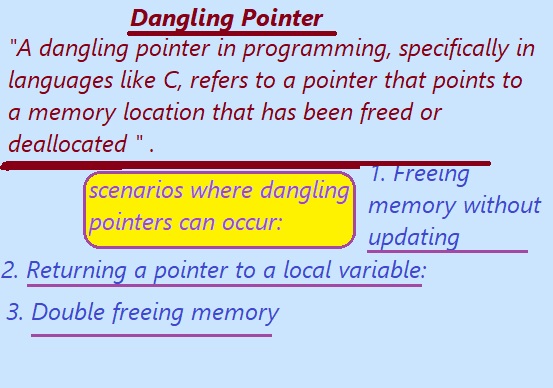Dangling Pointers in C programming.
Dangling Pointer:“A dangling pointer in programming, specifically in languages like C, refers to a pointer that points to a memory location that has been freed or deallocated .“
This can happen when the memory the pointer is pointing to has been released or is not valid, but the pointer itself has not been updated to reflect this change. As a result, the pointer "dangles" or points to a memory location that has been reallocated to another part of the program or is no longer accessible.
To avoid dangling pointers in C, it is important to always update pointers or set them to NULL after freeing the memory they point to. Additionally, it is best to avoid using pointers that point to memory that has been deleted or is out of scope. Proper memory management and handling of pointers is important to avoid problems like dangling pointers in C programming.
Important scenarios in which dangling pointers can occur:
1. Freeing memory without updating pointers:
When memory allocated using functions such as malloc or calloc is freed using free , the pointer originally pointing to that memory location must be set to NULL to avoid becoming a hanging pointer.
2. Returning a pointer to a local variable:
If a function returns a pointer to a local variable that has gone out of scope after the function returns, the pointer becomes a dangling pointer because it points to memory that is no longer valid.
3. Double freeing memory:
If memory is freed more than once using the free function, this can cause pointers to dangling because the pointer may still point to the deleted memory location.
Preventing dangling pointers in C Language:
1. Avoid returning pointers to local variables from functions.
2. Always set pointers to NULL after freeing the memory they point to.
3.Be careful when passing pointers between functions to make sure they are valid.
4.Use tools such as static code analyzers and memory debugging tools to diagnose and prevent dangling pointer problems.
By addressing and understanding the concept of dangling pointers in C programming, developers can write more reliable and robust code that avoids memory-related issues and bugs .
C Program that demonstrates a dangling pointer:
#include <stdio.h>
#include <dos.h>
int main()
{
int *dang_ptr = (int *)malloc(sizeof(int)); // Allocate memory for an integer
* dang_ptr = 10; // Assign a value to the allocated memory
printf("Value pointed to by ptr: %d\n", * dang_ptr);
free(dang_ptr); // Free the allocated memory
// Accessing the memory location pointed to by ptr after it has been freed
printf("Value pointed to by ptr after freeing: %d\n", * dang_ptr);
return 0;
}
In this example, we allocate memory for an integer using `malloc`, assign a value to that memory location, and then free the memory using `free`. However, we attempt to access the memory location pointed to by ` dang_ptr ` after it has been freed. This results in a dangling pointer situation, where ` dang_ptr ` points to memory that has been deallocated, leading to undefined behavior.
Advantage of Huge Pointer
There are no advantages of dangling pointers in C programming. Dangling pointers can cause undefined behavior, crashes, and security vulnerabilities in programs. This is considered a programming error and should be avoided by properly managing memory and ensuring that pointers always point to valid memory locations.
Key Points to Avoind Dangling Pointer in C Language.
1. Undefined Behavior: Dangling pointers can cause undefined behavior when dereferenced or accessed. This can cause unexpected program results, crashes or memory corruption.
2. Security Vulnerabilities: Dangling pointers can be used by malicious actors to manipulate memory and definitely execute inconsistent, unreasonable or authoritarian.
code, creating security vulnerabilities in programs.
4. Memory Leaks: Dangling pointers can prevent memory from being properly deallocated, leading to memory leaks and inefficient memory usage in a program.
3. Program Stability: Dangling pointers can cause unexpected behavior, crashes, and destabilization of programs, making it difficult to debug and maintain complex code.
5. Best Practices: Proper memory management practices, such as setting pointers to NULL after freeing memory and avoiding the use of pointers to deleted o r deallocated memory, are essential to writing robust and reliable C programs.
